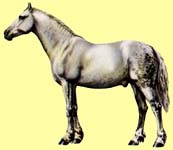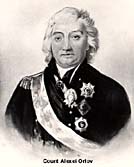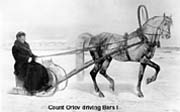|
|
Orlov Trotter |
|
|
Orlov Trotter |
| Group | Warmblood of meso-dolichomorphic type |
|---|---|
| Influences |
|
| Characteristics |
|
| Colors |
|
| Odd Facts |
|

Its body is deep through the girth with strong loins and powerful, muscular quarters. It has a long and straight back. The croup is a little elongated and slightly sloping, but powerful. The tail is well set-on and in movement it is carried high. The fine legs are set square and are well made of good, dense bone. Its sturdy legs are particularly strong, with good muscle structure and solid, clean joints. The hind legs and hocks are strong and capable of delivering a powerful propulsive thrust. The forearm and leg are long. The cannons are also long, with a good thickness. The tendons clean and well-defined. The hoof is well formed, and there is some feathering on the legs.
The required bone measurement in the legs is 8 in (20cm). The breed standard calls for a barrel length of 5 ft 4 in (1.63 m) and a depth through the girth of 6 ft 1 in (1.83 m). The strong Dutch influence did not always benefit the limbs, which at one time were prone to bursal enlargements, pronounced tendon weaknesses and even boen deformation. These deficiences have been largely overcome in the modern Orlov. The Orlov is a long-lived, tough sort of horse used under saddle and in other sports.
The Orlov Trotter breed was started in 1777 by Count Orlov, in Russia. For many years the Orlov was the best-known trotting horse in the world. Count Orlov began with an Arab stallion called Smetanka, and he sired a colt named Polken. Polken was in turn put to a Dutch mare and sired the founding Orlov stallion named Barrs.
Trotting races were popular in Russia by the 1790s -- the first being held in Moscow. Orlovs were bred primarily for racing although they were also used as saddle horses and for pulling troikas (three-horse carriages or sledges). However, when the American Standardbred was developed in the 19th century, the Orlov was no longer the fastest trotter. As a result, some Orlovs were crossed with Standardbreds and their offspring became known as Russian Trotters.
The troika is a Russian method of harnessing three horses side-by-side. The center horse works at a fast trot. The out-spanners are bent outward by tight side reins. They must canter or gallop to keep up with the center horse. A Russian Droshky, was presented to Queen Victoria's husband, Prince Albert. It was drawn by an Orlov wearing a typical Russian harness that includes the arch, or douga.
Count Alexei Orlov became commander of the Russian fleet for Tsarina Catherine (II) for his aid in deposing the future Peter II. Following his victory over the Turkish navy, he was presented with an white Arabian stallion named Smetanka by the Turkish admiral (the Sultan of Turkey) who paid homage to his chivalrous conduct. At his Orlov Stud outside Moscow, Count Orlov crossed this stallion with several Danish, Dutch Harrdraver, Mecklenburg, and Arabian mares, but only after one season Smetanka died.
Count Orlov used a strict process of selection, involving the use of Danish, Dutch, English, Russian, Polish, and Arab mares, together with important contributions from various English Thoroughbred stallions. In 1778 a Danish mare (with a dun coat and much Spanish blood, possibly a Fredericksborg), who had been covered by Smetanka, produced a stallion called Polkan I.
Polkan I who was one of the five offspring sired by Smetanka during his short stud carrer. Polkan inherited the bad as well as the good features of his father, and in particular his forehand action was poor. Count Orlov mated Polkan with Hartsdraver, a black Dutch Harrdraver mare with substantial bone and substance, and who moved with the necessary freedom and energy at the trot. The result was a phenomenal trotting horse called Bars 1 in 1784.
 In 1788 Count Alexis Orlov concentrated his breeding program at his new Khrenov Stud in the province of Voronezh. The best of the modern Orlovs are still bred at Khrenov. Bars I, who was foaled in 1784, was used extensively at the new stud of Khrenov. It was at Khrenov that from 1788 Count Orlov and his stud manager, V.I. Shishkin, continued to work on the evolution of the Orlov.
In 1788 Count Alexis Orlov concentrated his breeding program at his new Khrenov Stud in the province of Voronezh. The best of the modern Orlovs are still bred at Khrenov. Bars I, who was foaled in 1784, was used extensively at the new stud of Khrenov. It was at Khrenov that from 1788 Count Orlov and his stud manager, V.I. Shishkin, continued to work on the evolution of the Orlov.
Bars I is regarded as the progenitor of the breed. He served mares of the breeds from which he himself derived: Arabians, Dutch, Danish, Mecklenburgs, Thoroughbreds, Norfolk Trotters, Arabian/Mecklenburg crosses and British half-breds. In order to fix the type, there was considerable in-breeding to Bars I and his sons, even to Polkan I. The resulting purebred Orlovs to to the present time have Bars First in their progenies. Trotting races were held in Moscow as far back as 1799 and as the sport developed during the nineteenth century so the Orlov prospered and became faster.
The distinctive characteristics of this breed were established by the time harness racing became a popular equestrian sport in the 1830s. Individuals were tested on the race track and those with poor performance records were not used for future stock. With this strengthing of the type, the breed was improved until it gained notoriety as a supreme trotter around the world. By the close of the 19th century, over 3000 Russian stud farms specialized in the breeding of Orlov Trotters.
In 1865 the Stud Book was founded. Entry into the book was originally open to horses of any breed that had achieved times of under two minutes over a kilometer. Registration is now restricted solely to subjects whose sire and dam are already entered in the book. Since 1834, systematic training and graded trotting race programs have been held in Moscow. These programs have encouraged improvements and increased the speeds attained. In in this respect, though, the Orlov could never approach the American Standardbred, which by this latter half of the 19th century was quickly becoming quite popular.
In 1917, the Russian Revolution disrupted the Orlov breeding program. The Orlov's breeding was restored when peace returned, but it never regained the international supremacy it had during the 19th century. By this time, the American Standardbred had taken its place. To improve racing times, Russians crossed some of their Orlovs with the Standardbred resulting in the faster Russian Trotter.
Between 1890 and 1917, 156 Standardbred stallions and 220 mares were imported. The supply stopped during the First World War, and the crossbred horses were increaseingly interbred with backcrosses to the Orlov. In the 1930s more use was made to the Standardbred/Orlov cross, and in 1949 the Russian Trotter was recognized as a breed, although it by no means ousted the traditional and well-established Orlov.
While the modern Orlov is hardly a perfect conformational specimen, it is still an excellent trotter. It can be a bit hairy about the heels (common in appearance), but it is reasonably large, standing 16 hands (64 in), and is proportionate in its outline. The smallish head tends to be plain and somewhat coarse, and the less than well-made types can be somewhat long in the leg, with insufficient depth of girth. Orlovs are sometimes prone to tendon weakness, a legacy to the later overuse of Dutch mares.
The breed type varies according to the stud where the animals are bred, but the best and most characteristic are those bred at Krenov. Others, such as those bred at Perm in the Urals, are more common in appearance, while both the Tula and Dubrov types are closer to the heavier harness conformation than to that of a harness racer. These heavier Orlovs are, nonetheless, useful crosses that can be used to improve a wide variety of stock, a purpose that has always been part of Russian breeding policies.
The tall, handsome Orlov has also been used increasingly to upgrade other breeds. It passes on its useful qualities of height and strong light conformation. In this role the Orlov has exerted a powerful influence on Russian breeding, and has contributed to the evolution of the Don and the Tersk, the Russian Trotter, and some heavy Russian breeds.
The Orlov Trotter even contributed to the formation of other trotting breeds, and, in fact, at the end of the 19th century a number of mares were imported into France, while many horses were introduced into Italian and German studs. The Orlov Trotter was also used as the basis for the German Trotter, a breed that has since been improved by crossing with the American Standardbred and the French Trotter to produce a small horse a very long-striding action.
Because the Orlov is a sturdy breed, it has been, and still is, used for light draft and farm work. As a racing trotter, having once swept the field in the second half of the 19th century, the Orlov has now given way to the faster trotters -- the French Trotter and the American Trotter (Standardbred). Since the Orlov is much used to upgrade other breeds, there is a great emphasis placed on preserving it best qualities. These qualities include: its height, elegant conformation, a powerful yet light build, strong tendons, its potential to trot at speed, as well as improving its performance. Today, there are probably as many as 30,000 Orlovs in Russia and its former republics.
While it can no longer compete in terms of speed with these, the Orlov still competes today on Russian racecourses in races reserved for the breed. Of all the great champions of the breed, Ulov (1928) is perhaps the most outstanding. Ulov, at the age of five, trotted a distance of 1,600 meters (1 mile) in 2 minutes 5.1 seconds.
 For more information visit:
For more information visit:

|
© 1997-2018 NW Breyer Horse Club & Refiner of Gold Creations Equinealities in place since 1997, Section in place 2001, Updated 2/19/2018 |



|
| ||

|
|||||